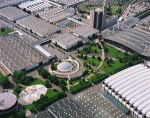
 The floorplan of CeBIT 2004 unveils the inception of an underlying revolution in the format of the biggest ICT fair in Europe, in a fierce attempt to revert the drop of exhibitors and visitors realised on the last two years. The whole idea resides on the creation of new vertical areas aimed at boosting visitors interest and meeting their needs. This and other projects are disclosed in a first-hand interview with Reinhold Umminger, CeBITs director, who already expects a 10 per cent loss on the exhibitors turnout for 2004.
The floorplan of CeBIT 2004 unveils the inception of an underlying revolution in the format of the biggest ICT fair in Europe, in a fierce attempt to revert the drop of exhibitors and visitors realised on the last two years. The whole idea resides on the creation of new vertical areas aimed at boosting visitors interest and meeting their needs. This and other projects are disclosed in a first-hand interview with Reinhold Umminger, CeBITs director, who already expects a 10 per cent loss on the exhibitors turnout for 2004.
Europe Contact Center The buzzword convergence marked CeBIT 2003. Which will be the hot-dish for next year?
Reinhold Umminger Mobility. In Europe everybody is talking now about the use of UMTS in the mobile phone sector. Wireless LAN is also prominent, as hotspots are spreading out through airports, hotels and universities. I think people will rush to CeBIT to get information on every mobile device.
ECC Since 2001, CeBIT has seen a significant decrease on both visitors and exhibitors. How do you justify this slump?
RU Of course the difficult situation in the IT industry affected many companies. Some of them are not on the market anymore or they just reduced their marketing budgets and fair participations. CeBIT indeed saw a reduction of companies but not as much as other international trade fairs in the IT sector. Our advantage in terms of visitors and standspace is even bigger than before the downturn.
We are just working on new concepts to attract visitors and exhibitors to participate in our fairs. I think in the future there must be some other services for companies to have these marketing-tool fairs in their portfolio.
ECC But dont these drops also reflect the demise of CeBITs format? What kind of initiatives are you planning to counter this trend?
RU CeBITs format is being reassessed and reformulated. CeBIT has been a very horizontal fair in the past, pretty much product-oriented. Starting 2004, and through 2005/6, our goal is to find out the vertical solutions and applications in the IT industry. We have to attract the visitor directly, with his problems and things he wants to see. This means that we wont have a big sector called Software & Services, but instead we will divide it in different sub- sectors like ERP solutions, CRM solutions, SCM solutions and so on.
ECC Which figures do you expect to reach in terms of exhibitors and visitors for 2004?
RU We would like to reach the figures from this year in terms of exhibitors [6602, against 7264 in 2002]. We realised a mutation on applicants behaviour. In former times, CeBIT was sold out in September before the fair, whilst right now we are still getting applications. Companies are clearly postponing their decision to participate till 2004, when an upturn is expected. For 2004 our expectations range between 6,000-6,500 exhibitors, which is 10 per cent less than last year. Anyway, I think a 10 per cent loss in this area is quite good.
Estimating the number of visitors is far more complicated. This year we had 550,000 visitors [against 675,000 in 2002] from almost 100 countries. We expect that the spring of 2004 will blow away the dark clouds hovering this industry, so people can come there and invest their money.
ECC Last year, Deutsche Messe introduced an elite ICT Forum and a special initiative aimed at SMEs. What novelties have you planned for this year?
RU The ICT World project will be kept next year during the day before and the first day of the fair. We are working together with an external partner and already got confirmed as key-note speakers people like Tom Siebel, Arun Sarin, René Obermann and Robert Bishop. I think it is an important thing to get the CEOs of the big companies together to discuss IT things.
We will carry on the SMEs project as well. We think that this sort of companies spread out over all branches will have to invest in IT. In the last three or four years they reduced the investment and this was actually one of the reasons for the breakdown in this area. We think 2004 will be a restart for these businesses.
We will have a meeting point on the fairground in hall 6, where the investors will have special presentations and discussions with important people. Thence we will guide the visitors to the exhibitors. We have ten top themes on the fair, like business processes and security, aimed at matching visitors interests and concerns. The visitor will have a guide which will lead him to the companies displaying products hes interested in.
In hall 11, in an area comprising 6,500 sq. metres, we will introduce a space dedicated to e-government the Public Sector Parc (former ENAC). In this space we will have 280 exhibitors, showing different products on the e-government sector and theres also special presentations, discussions and speeches. The Public sector Parc is just an example of how wed like to demonstrate the different product categories on the fairground: if the visitor comes into the fair, he will get all the information he needs in just one hall.
ECC Do you have any bespoke projects for the contact centre, CRM and telecommunications markets?
RU We have been in touch with many exhibitors having some CRM solutions, like Siebel, and with the organisers of the CRM Expo in Hessen. CRM is one of the focus areas for the orientation of the upcoming CeBIT. We dont have any special initiative but this will be one of the issues for 2005.
Telecos is quite a big field, comprising something like seven halls. It is just too general to call seven halls telecommunications. We need to identify certain vertical fields, which we can organise in such a way the visitor finds his solutions easily.
Filipe Samora
2003-12-19
Notícias
Em Foco – Pessoa

